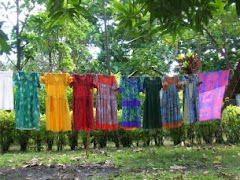Basics.
There is a little less than 300 people on the whole island and there are 5 villages (I live in Erata & there is Lawaima, Lakilia, Tafea, Mu-ur). The island is about 2 km by 4 km (and if I want to jog around to all 5 of the villages it takes about 45min), with a rocky shoreline and steep cliff (all the villages are located on top (about a 30min hike up– so no problem if a tsunami hits). No volcanoes but I do feel small earthquakes often. The local language is called Namakura, but most know Bislama (pidgin English) and few know English.
Religion.
There are 3 different types of churches on the island: Presbyterian (with the largest congregation), New Covenant (2nd largest) and Bible Church (the smallest).
Transport.
There are no trucks on the island so everything is carried. No airport but if you want to take a plane you have to take a boat to Tongoa first. Cargo ships can take you to Vila but can take anywhere from 12 hours to 2 days – it’s not a comfy ride, standing or sitting only – not a cruise ship. In an emergency or if you’re a high roller you can take a helicopter for $1000 US.
Electricity.
The island has no electricity. Most families use kerosene lanterns at night. Some have generators to charge electronics or sometimes watch movies. And very few have solar.
Communication.
Cell phone service is hit or miss and only certain areas on the island get reception. The closest spot for me is across the field and through someone’s yard to a ‘lookout point’. Of course when the reception goes in and out it does make it tempting to fling yourself over the cliff – joking but truly devastating being interrupted or not getting through at all. There are a few land lines run on solar, but even that is not always reliable. Finally if all else fails I’ve got a satellite phone.
My address is the same
Peace Corps
PMB 9097
Port Vila, Vanuatu
South Pacific
There is no post office on Tongariki and so my mail has to be shipped to me from the PC office. This means mail is less frequent and dependent on ship schedules (which is whole other story for another blog post).
Agriculture.
The food is free. I’d say ¼ of the island is houses and ¾ is gardens so there is always plenty to eat. Such as: watermelon, pineapple, cucumber (they are huge!), manioc (cassava), kumula (sweet potato), papaya, mango, nuts, oranges (rare but sometimes), lemons, grapefruit (and they are sweet), corn, yam, cabbage and more. I like the island food (aelan kakae) but of course I miss the cheeseburgers, salads and Mexican food. Everyone on the island tells me I’ll be fat fat when I leave and I think they are doing their best to help me achieve that by always bringing me plates of food. Maybe they are fattening me up to roast me and sacrifice me to the volcano (there actually is no volcano on Tongariki but if there was…). As for cannibalism (if you’re wondering) the last guy to be eaten was in the late 1800s and stopped because the missionaries came to Tongariki and told them it really isn’t the best negotiation tactic. I agree :)
Economy.
Everyone eats from their garden so no paying for food (well this would be the case if the villagers didn’t love “white man kakae” so much so they do spend the money for flour, rice, crackers, cookies, and etc). So for the other necessities like soap, kerosene, transport to come to Vila, etc - some will work in Vila and send money back, others try to sell food , kava or mats in the market in Vila or sell meat (chicken, goat, pig or cow) to other families on the island. Unfortunately, there are no organized farms that export any great amount and transportation to Vila is unreliable to send meat or fish quickly enough. It makes times hard for them, but they make do and are thankful for what they do have.
Sunday, November 15, 2009
Subscribe to:
Post Comments (Atom)




No comments:
Post a Comment